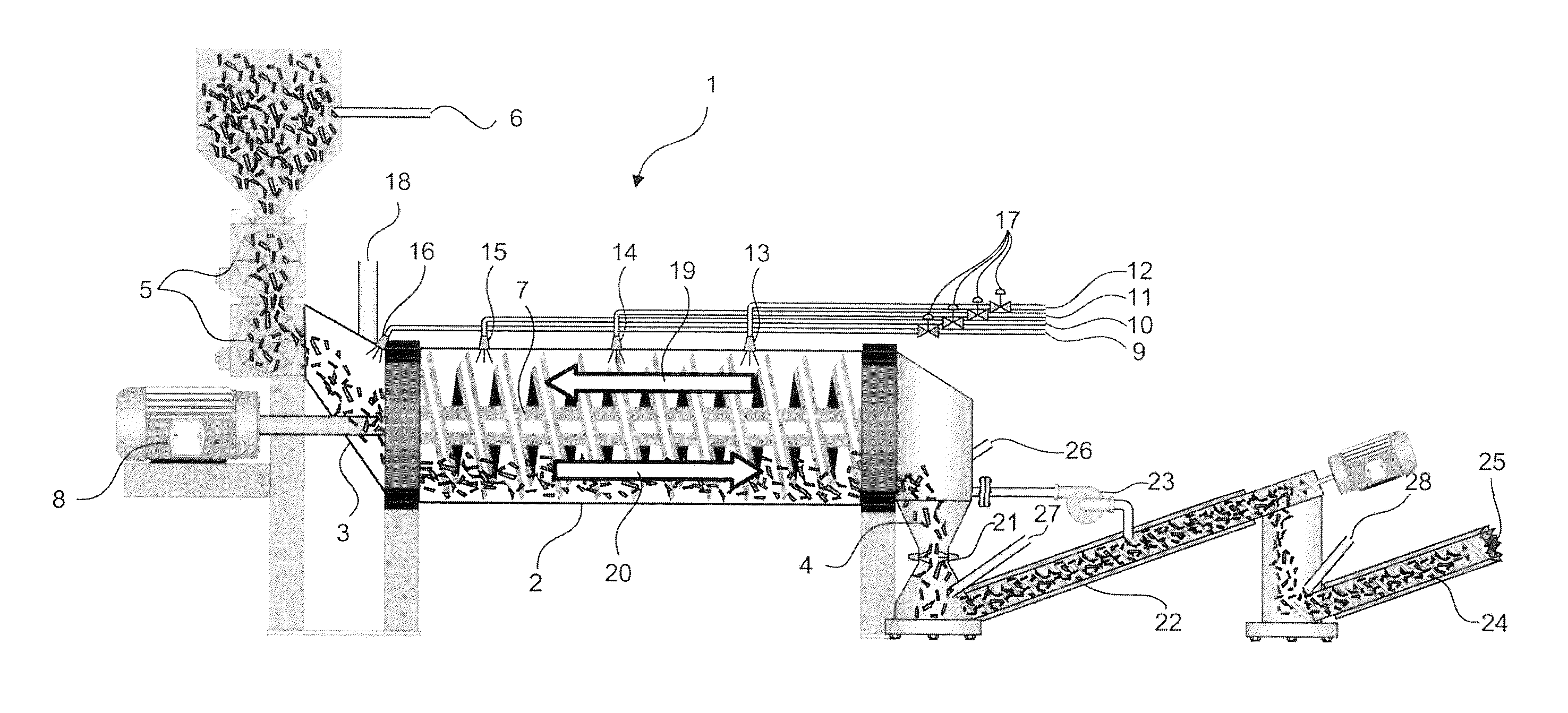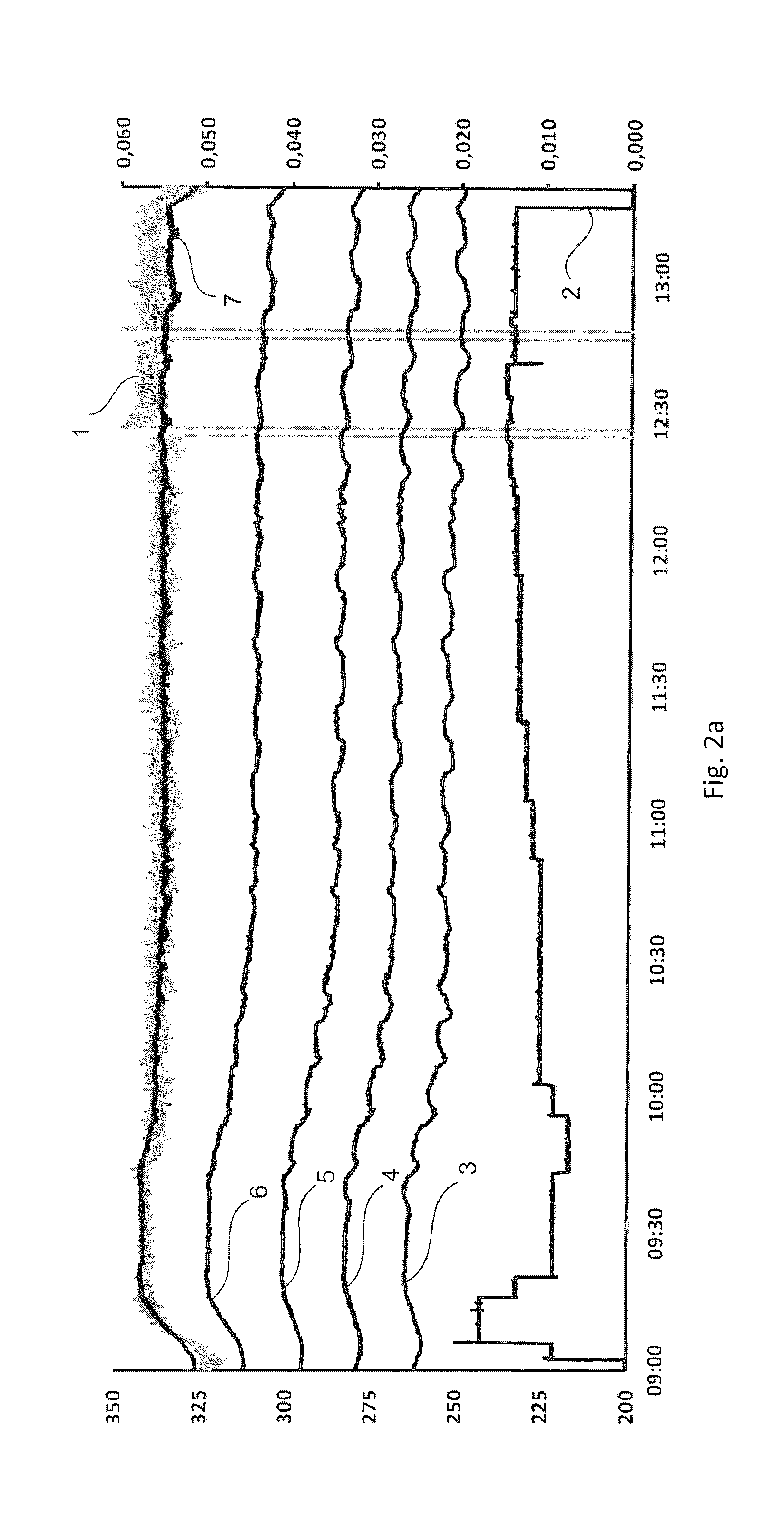Countercurrent oxygen enhanced torrefaction
a technology of countercurrent oxygen and torrefaction, which is applied in the direction of combustion types, drying machines, lighting and heating apparatuses, etc., can solve the problems of unfavorable addition of water, lower heating value of fuels based on renewable biomass, and lower energy density, so as to reduce heating and torrefaction time and energy efficiency.
- Summary
- Abstract
- Description
- Claims
- Application Information
AI Technical Summary
Benefits of technology
Problems solved by technology
Method used
Image
Examples
example 1
[0070]FIG. 1 shows a system for the torrefaction of a biomass (1) comprising a torrefaction reactor (2) having a biomass inlet (3) and a biomass outlet (4). The biomass is predried to a moisture content of about 5% (w / w) prior to feeding the biomass in to the torrefaction reactor (2) via rotary vane feeders (5). The moisture content in the biomass is controlled by a moisture probe (6). When the biomass enters the torrefaction reactor (2) via the biomass inlet (3) the temperature of the biomass is about 100° C. The biomass is transported through the torrefaction reactor (2) by means of a transport screw (7) which comprises helicoidal material transport device fixed to a central shaft (7). The speed of the biomass transport is regulated by the rotational speed of the transport screw (7) which is driven by a transport screw engine (8). An oxygen containing gas is injected to the torrefaction reaction via a gas inlet for injection of an oxygen containing gas (9, 10, 11, 12). The oxygen ...
example 2
[0071]Torrefaction of biomass was performed in a continuous torrefaction pilot plant having a torrefaction reactor comprising a 1.7 m long rotating drum with an internal screw fixed to the drum. A heated transport screw before the torrefaction reactor acted as a preheater and heated the bone-dry biomass to about 150° C.
[0072]In the torrefaction reference experiments, external electrical heaters heated the reactor. The heaters were controlled so that an isothermal drum surface temperature was reached and so that the biomass was heated to the final torrefaction temperature read at the exit of the torrefaction reactor through an IR-thermometer. The torrefaction gases were flowing concurrently with the biomass and withdrawn from the torrefaction reactor at the end of the reactor.
[0073]In the “counter current oxygen enhanced torrefaction experiments” (CC-OET) all external electrical drum heaters were turned off except for the electrically heated preheater. Oxygen containing gas was injec...
example 3
[0080]FIG. 2a shows that the temperature of the biomass can be kept stable using the method according to the present invention. In this experiment a wood mixture was torrefied at a biomass surface temperature of about 338° C. with countercurrent gas flow during injection of air and 7.5 minutes residence time. At time 12:00 the process was determined to be at steady-state. The x-axis shows the time in hours:minutes, the left y-axis shows the temperature and the right y-axis shows the lambda value. Curve (1) shows the biomass surface exit temperature, curve (2) shows the corresponding lambda value, curve (3-7) shows the gas temperatures in the centre of the torrefaction drum, where (3) is closest to the biomass inlet and (7) is closest to the biomass exit.
[0081]FIG. 2b shows the combustibility of the torrefaction generated gas during torrefaction of the wood mixture at 338° C. biomass surface temperature with countercurrent gas flow during injection of air and 7.5 minutes residence ti...
PUM
| Property | Measurement | Unit |
|---|---|---|
| temperature | aaaaa | aaaaa |
| temperature | aaaaa | aaaaa |
| temperature | aaaaa | aaaaa |
Abstract
Description
Claims
Application Information
 Login to View More
Login to View More - R&D
- Intellectual Property
- Life Sciences
- Materials
- Tech Scout
- Unparalleled Data Quality
- Higher Quality Content
- 60% Fewer Hallucinations
Browse by: Latest US Patents, China's latest patents, Technical Efficacy Thesaurus, Application Domain, Technology Topic, Popular Technical Reports.
© 2025 PatSnap. All rights reserved.Legal|Privacy policy|Modern Slavery Act Transparency Statement|Sitemap|About US| Contact US: help@patsnap.com



